CHEOPS: A guide to ESA's exoplanet investigating mission
CHEOPS is busy identifying "golden targets" to inform and direct deeper study missions.
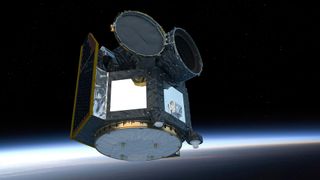
The Characterising Exoplanet Satellite (CHEOPS) is a European Space Agency (ESA) spacecraft with the primary goal of studying bright, nearby stars that are known to be orbited by their own planets.
As such the mission takes the science of planets around other stars, extrasolar planets or "exoplanets," beyond detection and into the realms of deep investigation. ESA says that CHEOPS is the first exoplanet follow-up mission and makes high-precision observations of a planet's size, and atmospheric characteristics as it passes in front, or transits, the face of its star causing a tiny dip in light.
The mission focuses on planets with sizes between a few times that of Earth, super-Earths, and that of the solar system ice giant Neptune.
Related: The 10 most Earth-like exoplanets
A joint mission of ESA and Switzerland, led by the University of Bern (UNIBE) in collaboration with the University of Geneva (UNIGE) the 5.2 ft (1.6 meter) tall, 640 Ilbs (290 kilogram) CHEOPS satellite lifted off from ESA's launch site in Kourou, French Guiana atop the Arianespace Soyuz-Fregat rocket VS23 on Dec. 18, 2019.
According to the ESA CHEOPS orbits Earth at an altitude of around 435 miles (700 kilometers) in what is called a "sun-synchronous orbit" which takes it over the poles of Earth while maintaining the same fixed position in relation to the sun. This means it passes over the same point on Earth at the same time every day.
CHEOPS is integral to exoplanet science going forward selecting what the California Institute of Technology refers to as "golden target" exoplanets. These are worlds with atmospheres that a prime for follow-up investigations with other instruments, including the most powerful telescope humanity has ever launched into space, the James Webb Space Telescope (JWST).
As such the research conducted using CHEOPS could help finally identify planets with atmospheric compositions that could indicate either the suitability to host life or the possible presence of life itself.
CHEOPS FAQs answered by an expert
We asked Isabella Pagano from the Astrophysical Observatory of Catania, Italy, some questions about ESA's CHEOPS mission.

Isabella Pagano is a member of the CHEOPS Board and Science Team from the Astrophysical Observatory of Catania, Italy.
What is the primary mission of CHEOPS?
The characterization of exoplanets, measuring the radius of transiting planets, deriving accurate information on the architecture of the system to which a given exoplanet belongs, for instance, the presence of other planets in the system, and deriving information on the presence of properties of the exoplanet atmospheres.
What makes CHEOPS so adept at classifying the atmospheres of exoplanets?
CHEOPS offers the possibility to monitor a target for a long time with accurate photometric precision. This allows us to register the small variation of the amount of light we receive from the system, and how this changes with the orbital phase of the planet. For a planet close to the star we can record the amount of stellar light reflected by the planet. Since this is linked to the properties of the reflective surface, in such a way we can argue on the temperature of the planet's surface, the presence of an atmosphere, or even cloud circulation.
How does CHEOPS link up with the James Webb Space Telescope?
The JWST can perform spectroscopy of exoplanet atmospheres, and there are a number of CHEOPS studied atmospheres that will be deeply investigated by JWST.
The Origins of CHEOPS
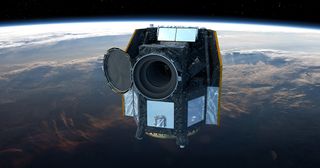
CHEOPS started life as the first mission of ESA's small Science Program selected in October 2012 and chosen for implementation in Feb. 2014, according to ESA.
The mission entered its implementation phase in July 2014, its cost forESA capped at €50 million. The development of CHEOPS was fast-tracked with the satellite's systems adapted from existing flight-tested products.
The prism-shaped spacecraft was built by Airbus Defence and Space, Spain. The primary optical instrument is mounted atop the main body and the sides of the spacecraft are adorned with three body-mounted solar array panels harvesting energy from the sun. This helps support CHEOPS' battery in providing the satellite's instruments with a continuous 60 Watts of power, which can be boosted to 70 Watts over short periods.
Keeping CHEOPS from overheating and protecting it from direct solar radiation is a fixed sun shield attached to the central solar panel. At the bottom of the craft are its propulsion module thrusters and an S-band –Z antenna that helps it send 1.2 Gigabytes of data back to Earth every day.
Following its launch in Dec. 2019, the cover of CHEOPS' telescope was removed on Jan. 29, 2020, and made its first observation of the universe, or "first light" on Feb. 7 of that year, zooming in on the star HD 70843. ESA selected this yellow-white star located around 150 light-years from Earth because of its brightness and its position in the sky which made it ideal for testing purposes.
How does CHEOPS hunt for exoplanets?
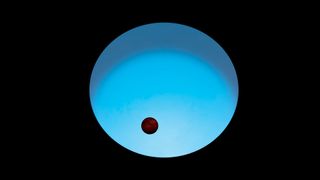
CHEOPS carries a single medium-sized 12-inch (300-millimeter) effective aperture 3.9-ft (1.2-meter) long Ritchey–Chrétien telescope (RCT) with ultrahigh photometric precision. In the focal plane of the telescope is a charge-coupled device (CCD). Collectively the detector, support electronics, telescope, back-end optics, instrument computer, and thermal regulation hardware are called the CHEOPS Instrument System (CIS).
Las Cumbres Observatory explains that CHEOPS' photometry counts the number of photons incident on CCD pixels via the number of electrons it stores, with more electrons indicating more photons and thus a brighter object. That means it is a good way of measuring changes in the brightness of a star, changes that could be brought about by a transiting exoplanet.
A typical CHEOPS observation of a star lasts around 48 hours. The images produced by the mission are intentionally quite blurry, with the telescope delivering intentionally defocused light to its CCD.
This is done so the light from each star is distributed over many pixels. Ironically this makes the measurement of starlight more precise as it means the instrument is far less sensitive to small differences in individual pixel responses to light. It also makes the RCT less vulnerable to changes in how it is pointed.
CHEOPS's orbit and stiff optical bench mounting allow the RCT instrument to point at a target object with high precision while ensuring the target moves as little on the CCD detector as possible. Staying within strict boundaries helps make sure that measured changes in light are a result of exoplanet transits not changes in the motion of the telescope.
Assisting CHEOPS with stability is the Altitude and Orbit Control System (AOCS) which ensures one axis of the satellite is always orientated toward Earth. The spacecraft itself rotates around the line of sight of the RCT to keep the instrument always pointing to deep space, this also means that the CCD detector is passively kept cool at a temperature of around minus 40 degrees Fahrenheit (minus 40 degrees Celsius).
CHEOPS science milestones
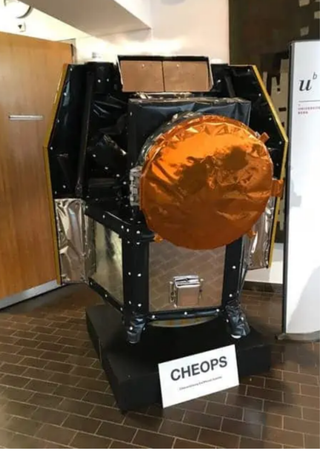
It wasn't long after CHEOPS first opened its metaphorical eyes to the cosmos that the satellite began delivering extraordinary results.
In Sept. 2020 the first findings from CHEOPS revealed a previously discovered exoplanet is what ESA describes as one of the hottest and most extreme exoplanets known to date, "ultra-hot Jupiter" named WASP-189 b.
Initially discovered in 2018, WASP-189 b is twenty times closer to its parent star than Earth is to the sun and completes an orbit in just 2.7 Earth days. The system immediately intrigued astronomers as it is the brightest hot Jupiter spotted thus far that can be seen passing in front of its stars.
CHEOPS discovered another exoplanet with extreme characteristics in Jan. 2022 when it found an exoplanet shaped like a football, orbiting its parent star in just a single Earth day. The planet WASP-103b is located in the constellation of Hercules and has been deformed by the strong tidal forces between itself and its host star WASP-103, which is almost twice as large as the sun. This was the first time that the deformation of an exoplanet had been detected and as such, it offered astronomers new insights into the internal structure of planets that orbit their stars at extremely close distances.
Despite its focus on planets outside the solar system, CHEOPS has made some important findings within our own planetary system too. In early 2023, astronomers spotted light being blocked by a ring surrounding the dwarf planet Quaoar. Too faint to be spotted by any other method, the ring is extraordinary because it is several times further out from its parent body than was previously thought possible for a ring system and may change our theories of ring formation.
How does CHEOPS work with the James Webb Space Telescope and other missions?
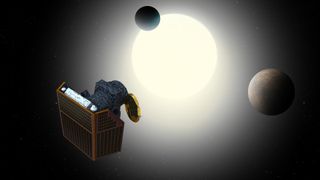
CHEOPS is a first-step characterization tool for exoplanets which means that it studies planets and their atmospheres to then determine which are golden targets that can be followed up by the JWST and other more powerful telescopes than CHEOPS itself such as the forthcoming Extremely Large Telescope (ELT).
"We are convinced with its high precision and flexibility, CHEOPS can act as a bridge between other instruments and Webb, as the powerful telescope needs precise information on potentially interesting observation targets," Willy Benz, Professor emeritus of astrophysics at the University of Bern and head of the CHEOPS consortium said in a statement. "CHEOPS can deliver this information — and thus optimize the operation of Webb."
Before CHEOPS can pass these targets along to the JWST they first have to be identified, and ESA's mini-satellite is helping in this regard too. According to Caltech one of the missions providing provisional targets for CHEOPS is NASA's Transiting Exoplanet Survey Satellite (TESS). TESS spots planets as they cross the face of their stars causing a drop in that star's light output. When TESS spots a potential exoplanet CHEOPS can then follow this up characterizing the exoplanet and its system using the same technique but studying it for longer. CHEOPS can even do this when TESS has seen a potential planet as a result of one transit of its star, a "monotransit," which indicates it has a long-term orbit and makes it otherwise difficult to investigate.
In a 2020 paper published in the Monthly Notices of the Royal Astronomical Society, the authors determined that CHEOPS is capable of following up on around 89% of the monotransits spotted by TESS and it could spot additional transits for around 70% of these exoplanets with long-period orbits. Caltech adds that CHEOPS can validate long-period orbit planets spotted by TESS and gather precise size and mass measurements for these worlds. That means CHEOPS can do far more than just act as a middle-man for TESS and the JWST.
How long will CHEOPS be operational and what comes next?
Upon launch, CHEOPS was given a 3.5-year science operations lifetime by ESA with a goal of lasting up to 5 years. In September 2022, the CHEOPS satellite celebrated its first 1000 days in space and over a million minutes of observation time, at this time it was revealed that the satellite is still in good working condition.
"Even after 1000 days in orbit, CHEOPS still works like a charm and only shows very small signs of wear, caused by energetic particles emitted by the sun," Andrea Fortier, CHEOPS instrument scientist and University of Bern researcher said in a statement. "It will continue its mission around the Earth until at least September 2023 but the CHEOPS team is working with the European Space Agency and the Swiss Space Office to extend the mission until the end of 2025 and possibly even beyond."
On March 7, 2023, ESA’s Science Programme Committee confirmed CHEOPS would continue operations to 2026 with a potential extension until 2029, contingent upon ongoing commitments from national contributors and partners.
When CHEOPS finally does cease operations the satellite will be superseded by two further ESA exoplanet-investigating craft, Planetary Transits and Oscillations of stars (PLATO) and Atmospheric Remote-sensing Infrared Exoplanet Large-survey (Ariel). Both missions are planned for the next decade according to ESA.
Plato is set to launch in 2026 and will study and characterize terrestrial planets in the habitable zones of their sun-like stars, while Ariel will study the composition of exoplanets, their formation, and evolution using a sample of 1,000 planets. Ariel is scheduled to liftoff no earlier than 2029.
Additional resources
One of the first exoplanets to be extensively studied by the CHEOPS was the gas giant WASP-189. You can read about this massive planet's characteristics as discovered by CHEOPS in these resources from NASA.
CHEOPS is helping revolutionize exoplanet science. The first exoplanet around a sun-like star was discovered in 1995 and since then NASA's exoplanet catalog has grown to over 5,000 confirmed entries with a further 9,000 or so candidates as of writing.
CHEOPS is looking to characterize Neptune-sized worlds, there is currently a mystery surrounding such planets and why they are absent from close around their host stars. Here, Space.com's Elizabeth Howell explains the mystery of the so-called "hot Neptunian desert"
Bibliography
Cheops, ESA, Accessed 03/03/23 [https://www.esa.int/Science_Exploration/Space_Science/Cheops]
Cheops Overview, ESA, Accessed 03/03/23, [https://www.esa.int/Science_Exploration/Space_Science/Cheops/Cheops_overview2]
Cheops, University of Bern, Accessed 03/03/23, [https://cheops.unibe.ch/]
CHEOPS, Measuring Exoplanets, Accessed 03/03/23, The Planetary Society, [https://www.planetary.org/space-missions/cheops]
W, Benz, C. Broeg., A. Fortier., et al., The Cheops Mission., Experimental Astronomy, [2021], [https://doi.org/10.1007/s10686-020-09679-4]
CHEOPS: Looking into the Heart of Exoplanets, Airbus, Accessed 03/03/23, [https://www.airbus.com/en/products-services/space/exploration/solar-system/cheops]
CHEOPS (CHaracterizing ExOPlanets Satellite), ESA Eo Portal, Accessed 03/03/23, [https://www.eoportal.org/satellite-missions/cheops#eop-quick-facts-section]
First results from Cheops: ESA's exoplanet observer reveals extreme alien world, ESA, [2020], [https://www.esa.int/Science_Exploration/Space_Science/Cheops/First_results_from_Cheops_ESA_s_exoplanet_observer_reveals_extreme_alien_world]
ESA's Cheops finds an unexpected ring around dwarf planet Quaoar, ESA, [2023], [https://www.esa.int/Science_Exploration/Space_Science/Cheops/ESA_s_Cheops_finds_an_unexpected_ring_around_dwarf_planet_Quaoar]
A perfect blur — First image by exoplanet watcher Cheops, ESA, [2020], [https://www.esa.int/Science_Exploration/Space_Science/Cheops/A_perfect_blur_First_image_by_exoplanet_watcher_Cheops]
A thousand days of CHEOPS space telescope, University of Geneva, [2022], [https://www.unige.ch/communication/communiques/en/2022/le-telescope-spatial-cheops-fete-ses-1000-jours]
A. Brandeker, K. Heng., M. Lendl., et al, CHEOPS geometric albedo of the hot Jupiter HD 209458 b⋆ Astronomy & Astrophysics, [2022], [https://www.aanda.org/articles/aa/abs/2022/03/aa43082-22/aa43082-22.html]
CHEOPS in a Nutshell, ESA, [Accessed 03/06/23], [https://www.cosmos.esa.int/web/cheops/cheops-in-a-nutshell]
Cheops: Photometric Precision, ESA, [Accessed 03/06/23], [https://www.cosmos.esa.int/web/cheops/performances-photometric-precision]
A Perfect Blur–First Image by Exoplanet Watcher CHEOPS, ESA, [2020], [https://sci.esa.int/web/cheops/-/a-perfect-blur-first-image-by-exoplanet-watcher-cheops]
Join our Space Forums to keep talking space on the latest missions, night sky and more! And if you have a news tip, correction or comment, let us know at: community@space.com.
Get the Space.com Newsletter
Breaking space news, the latest updates on rocket launches, skywatching events and more!

Robert Lea is a science journalist in the U.K. whose articles have been published in Physics World, New Scientist, Astronomy Magazine, All About Space, Newsweek and ZME Science. He also writes about science communication for Elsevier and the European Journal of Physics. Rob holds a bachelor of science degree in physics and astronomy from the U.K.’s Open University. Follow him on Twitter @sciencef1rst.
